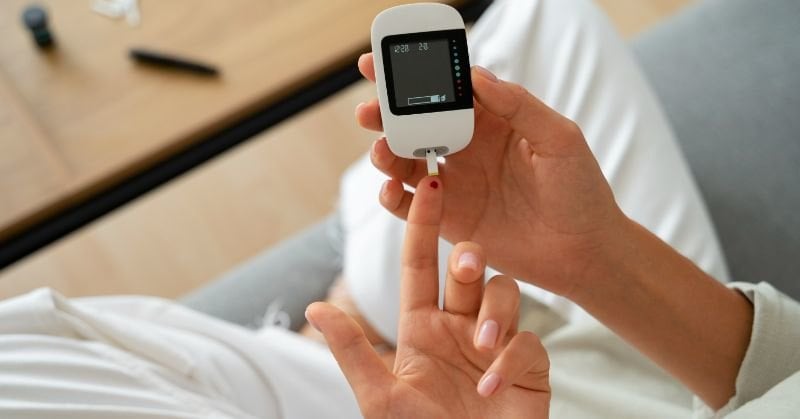Prediabetes is a critical warning sign of future health risks, especially the onset of type 2 diabetes. Understanding this condition, detecting it early, and taking preventive actions are essential steps in safeguarding long-term health, particularly in the United States, where diabetes is prevalent.

Understanding Prediabetes
What is Prediabetes?
Prediabetes is a condition where blood glucose levels are higher than normal but not yet high enough to be diagnosed as type 2 diabetes. It serves as an early indicator that the body is on the path toward developing type 2 diabetes if no interventions are made.
The Significance of Early Detection
Early detection of prediabetes is crucial because it offers a chance to prevent the progression to type 2 diabetes. More than 88 million American adults—over one-third—have prediabetes, and over 84% are unaware they have it. Proactive testing and lifestyle changes can help prevent long-term health issues.
How is Prediabetes Detected?
Common Diagnostic Tests
Prediabetes is detected through blood tests that measure glucose levels. The main tests include the A1C test, Fasting Plasma Glucose (FPG) test, and Oral Glucose Tolerance Test (OGTT). These tests are essential for early detection, enabling timely interventions.
| Diagnostic Criteria for Prediabetes | Blood Glucose Level |
| A1C Test | 5.7% - 6.4% |
| Fasting Plasma Glucose Test (FPG) | 100 - 125 mg/dL |
| Oral Glucose Tolerance Test (OGTT) | 140 - 199 mg/dL |
Risk Factors and Screening Recommendations
Risk factors for prediabetes include age (45+), overweight, family history of diabetes, and ethnic background (higher prevalence in African Americans, Hispanic/Latino Americans, Native Americans, and Asian Americans). The American Diabetes Association recommends screening for adults aged 45 and older, or younger if they are overweight with additional risk factors.
Strategies for Preventing Type 2 Diabetes
The Growing Epidemic in the United States
Prediabetes and type 2 diabetes have reached critical levels in the U.S., with over 88 million adults affected by prediabetes and 34 million living with type 2 diabetes. Key contributors include poor diet, lack of physical activity, and rising obesity rates, with about 42% of American adults being obese. Addressing these issues through preventive strategies is essential to curb this growing health crisis.
Lifestyle Modifications
Lifestyle changes are the cornerstone of preventing type 2 diabetes for individuals with prediabetes. Below are specific measures in areas like diet, exercise, sleep, and healthcare.
Dietary Recommendations
-
Balanced Nutrition: Emphasize a diet rich in whole grains, vegetables, fruits, lean proteins, and healthy fats. Limit intake of sugary foods, refined carbohydrates, and processed foods.
-
Portion Control: Manage portion sizes to avoid overeating, especially high-calorie foods. This can prevent weight gain and help manage blood sugar levels.
-
Consistent Meal Times: Eating meals at regular intervals helps maintain stable blood sugar levels throughout the day. Skipping meals can lead to blood sugar spikes and increased hunger.

Exercise and Physical Activity
-
Regular Physical Activity: Engage in at least 150 minutes of moderate-intensity exercise per week, such as brisk walking, cycling, or swimming. This improves insulin sensitivity and lowers blood sugar levels.
-
Strength Training: Incorporate strength training exercises at least twice a week to build muscle mass, which can help increase metabolism and control blood glucose levels.
-
Daily Movement: Make small adjustments to increase daily physical activity, such as taking the stairs instead of the elevator, parking farther away, or taking short walks during breaks.
Sleep and Stress Management
-
Prioritize Sleep: Aim for 7-9 hours of quality sleep per night. Poor sleep can disrupt insulin function and increase the risk of developing type 2 diabetes.
-
Manage Stress: Chronic stress can lead to insulin resistance. Practice stress-relief techniques such as yoga, meditation, deep-breathing exercises, or spending time in nature.
Healthcare and Monitoring
-
Regular Check-Ups: Schedule regular medical check-ups to monitor blood sugar levels and other health indicators like blood pressure and cholesterol. Regular monitoring helps track progress and catch any issues early.
-
Continuous Glucose Monitoring (CGM): For those at higher risk, using CGM devices can help track glucose levels throughout the day, providing real-time feedback on how diet, exercise, and stress affect blood sugar.
| Key Risk Factors for Prediabetes | Details |
| Age | 45 years or older |
| Weight | BMI of 25 or higher |
| Family History | Parent or sibling with type 2 diabetes |
| Ethnicity | Higher prevalence in African Americans, Hispanic/Latino Americans, Native Americans, and Asian Americans |
| Lifestyle | Physical inactivity, unhealthy diet |
Age-Specific Preventive Measures
Preventing the progression from prediabetes to type 2 diabetes requires tailored approaches based on age groups:
1. For Adults Under 45: Younger adults should focus on building healthy habits early. Regular exercise, balanced nutrition, and maintaining a healthy weight are key. More frequent screening is recommended for those with a family history of diabetes or belonging to high-risk ethnic groups.
2. For Adults 45 and Older: Since age is a significant risk factor, regular screening for prediabetes is crucial. Lifestyle interventions, such as increasing physical activity and dietary modifications, are essential. This group should also monitor other health indicators like blood pressure and cholesterol levels.
3. For Seniors (65 and Older): Older adults should work closely with healthcare providers to manage their overall health. Low-impact exercises, such as walking, swimming, or yoga, can be particularly beneficial. Nutritional guidance tailored to their needs, including managing any age-related dietary restrictions, is also important.
Health Insurance and Treatment Policies
Understanding healthcare and insurance options is crucial for managing and treating prediabetes. In the U.S., several health insurance plans, including those under the Affordable Care Act (ACA), cover diabetes screening and preventive services. Here are some points to consider:
-
Preventive Services Coverage: Most insurance plans cover prediabetes screening and counseling services as preventive care, which means they are often available at no cost to the patient under ACA-compliant plans.
-
Medicare Benefits: For those over 65, Medicare offers coverage for diabetes screening tests and diabetes prevention programs, including lifestyle change programs that focus on diet, exercise, and weight management.
-
Health Savings Accounts (HSAs): Individuals with high-deductible health plans can use HSAs to pay for eligible medical expenses related to diabetes management, such as glucose monitors, test strips, and other necessary supplies.
-
Access to Lifestyle Programs: Many insurance plans now offer access to diabetes prevention programs, which provide education and support for making sustainable lifestyle changes to prevent the onset of type 2 diabetes.
By understanding and utilizing these resources, individuals can better manage prediabetes and reduce their risk of developing type 2 diabetes.
Recognizing the Symptoms of Prediabetes
Symptoms to Watch For
While prediabetes often has no clear symptoms, certain signs may suggest its presence. These symptoms include:
-
Increased Thirst: Persistent thirst can be an early sign of high blood sugar levels.
-
Frequent Urination: The kidneys work harder to eliminate excess glucose, leading to more frequent urination.
-
Fatigue: High blood sugar levels can interfere with the body’s ability to use glucose for energy, leading to constant tiredness.
-
Blurred Vision: High blood sugar levels can cause the lens of the eye to swell, leading to blurry vision.
The Silent Nature of Prediabetes
Despite these potential symptoms, prediabetes often progresses silently, without noticeable signs. This is why regular screening, especially for those at risk, is vital. Many people discover they have prediabetes only after blood tests reveal elevated glucose levels. Early intervention can prevent the condition from escalating to type 2 diabetes.
Monitoring and Regular Check-Ups
Regular monitoring and check-ups are vital for managing prediabetes and preventing its progression to type 2 diabetes. Here’s a more concise yet comprehensive plan:
1. Daily Blood Sugar Monitoring: Use a home glucose monitor to check fasting glucose levels daily or several times a week, especially after changes in diet or exercise.
2. A1C Testing: Schedule A1C tests every 3-6 months to monitor long-term blood sugar control. Aim for an A1C level below 5.7%.
3. Annual Physical Exams: Include checks for blood pressure, cholesterol, and weight. Discuss overall health and any changes in symptoms with your healthcare provider.
4. Additional Screenings: Annually test kidney function and lipid profiles to catch any related health issues early.
5. Follow-Up and Adjustments: Schedule follow-ups based on your test results. Consider telemedicine for convenience. If blood sugar levels are high, intensify lifestyle changes and consult with your healthcare provider for possible further action.
This approach ensures comprehensive monitoring and timely interventions, helping to manage prediabetes effectively and prevent the onset of type 2 diabetes.
Conclusion
Recognizing and addressing prediabetes is a critical step in preventing the onset of type 2 diabetes. By understanding the risks, getting regular screenings, and adopting a healthier lifestyle, individuals can significantly reduce their chances of developing type 2 diabetes. Personal vigilance, informed decisions, and consistent lifestyle adjustments are essential to managing this growing health concern in the United States.
References
-
Centers for Disease Control and Prevention (CDC). "Prediabetes: Your Chance to Prevent Type 2 Diabetes." https://www.cdc.gov/diabetes/basics/prediabetes.html
-
American Diabetes Association (ADA). "Standards of Medical Care in Diabetes—2024." https://diabetesjournals.org/care
-
National Institute of Diabetes and Digestive and Kidney Diseases (NIDDK). "Preventing Type 2 Diabetes." https://www.niddk.nih.gov/health-information/diabetes/overview/preventing-type-2-diabetes




